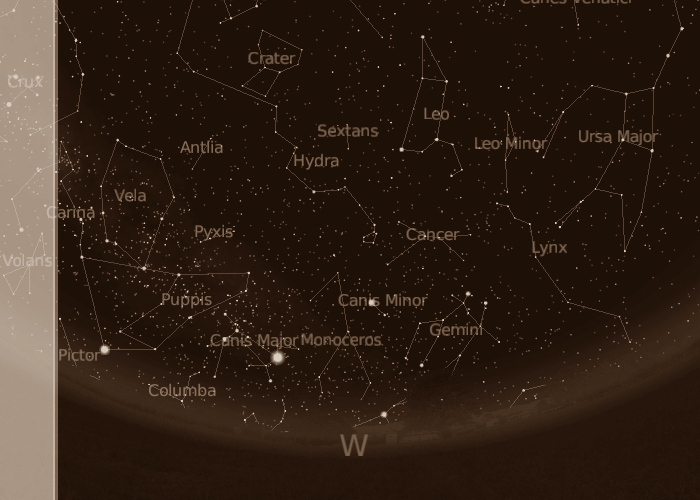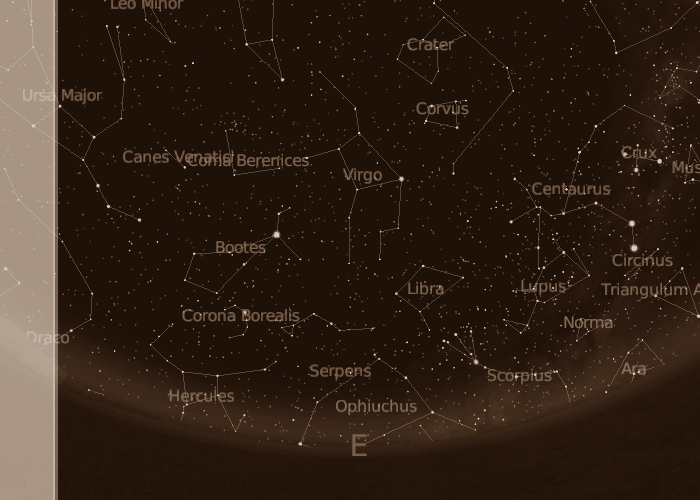Western Horizon
Eastern Horizon
Precisions About Daylight Saving Time (DST) Adjustments
![]()
Western Horizon
Eastern Horizon
Precisions About Daylight Saving Time (DST) Adjustments

It's the sky of the vernal equinox, now! That means that the show is to be searched on the southern horizon! It's there that you'll find that large band of Milky Way-embedded typical southern constellations! It's amazingly running from scorpius, the Scorpion, southeast, to Canis Major, the Great Dog, southwest. This band of constellations is typical of the southern skies. Lupus, the Wolf, is left of scorpius, as both the bright stars, further, are Alpha Centauri, and Agena, the so-called 'Pointers', as those stars are 'pointing' to Crux, the Southern Cross. The row further, westwards, is composed of the constellations which was parted, in the 18th century, from the antique and vast constellation Argo, the Ship, which was figuring the Ship Argo, the ship of the Argonauts, those Greek heroes who went in quest of the Golden Fleece. Omega Centauri, a splendid celestial object at the 3.7th magnitude, is seen at the upper left of Crux. The show, South, is further complemented -albeit high- by the fine and comparatively more feeble chain of Hydra, the Hydra, as Sextans, the Sextant, Crater, the Cup, and Corvus, the Crow, are anchoring along! Let's end up with West! The bright star there is Procyon, of Canis Minor, the Little Dog as the large quadrilateral of Gemini, the Twins is fine -albeit tending low. Cancer, the Crab, where Hydra, the Hydra is ending, is a fine constellation, as it's harbouring M44, this famed open cluster, Praesepe, the Beehive, a fine binocular object. The faint Lynx is northeast. to a printer-friendly chart
West for the mid-northern latitudes. West for the mid-southern latitudes

Let's turn East now! As the southeastern part of the sky is filled with the Milky way-embedded constellations we saw South, two bright stars are seen, high. Those are, from left to right, Arcturus, and Spica, respectively. Those two stars are the object of the famed astronomical saying, 'Arc to Arcturus, speed on to Spica.' That means that Arcturus and Spica -of the constellations Bootes, the Herdsman and Virgo, the Virgin- are easy to find in the sky as they are just along the extension of the three stars of the Big Dipper's handle. Just make that! The Big Dipper is now lying much northeast. Just follow the arch of the handle! First you'll find Arcturus, then Spica! A fine trick! Virgo, on the other hand, is home to deep-sky galaxy fields. Low, East, is Ophiuchus, the Serpent Holder, with one of its serpents above him. Interesting. Libra, the Scales are seen above Scorpion, the Scorpion. Another fine show, at last, is to be seen on the northern horizon! It's about the best for both the Dippers, the Great and the Little. Both those constellations are typical of the northern hemisphere skies, as the Great Dipper, this asterism part of Ursa Major, the Great Bear, is used to easily find the Polaris, hence the North. See how the Great Dipper is high in the sky! A fine show per se! Now, just spot the two leftmost stars of the dipper, left of the handle. Got them! Follow the line downwards. Here are the neighbourhoods of the Polaris. to a printer-friendly chart
East for the mid-northern latitudes. East for the mid-southern latitudes
->Contrarily to what is seen in the northern hemisphere, or the southern, equatorial and tropical countries do not have any Daylight Saving Time (DST), as at these latitudes days are equaling nights all year long
Website Manager: G. Guichard, site 'Amateur Astronomy,' http://stars5.6te.net. Page Editor: G. Guichard. last edited: 12/28/2010. contact us at ggwebsites@outlook.com